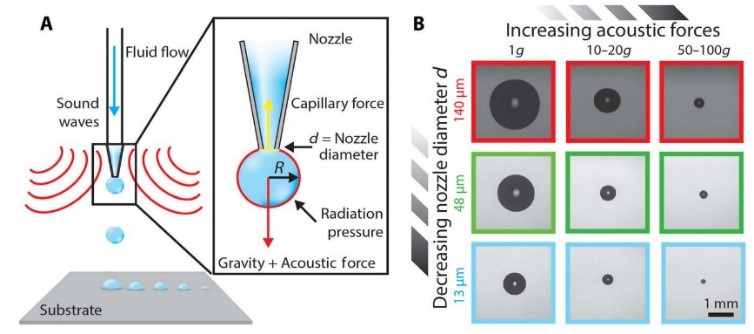3D printing research has grown exponentially only over the past 40 years. Technologies more and more accurate have been developed in order to achieve the perfect 3D model. What about the association 3D printing technology using sound waves? Nowadays the ultrasound technology has been associated to the 3D printing systems not only solid systems but also liquid. One of the most outstanding applications is in the 3D printing liquids! Yes, you are reading well! Harvard researchers propose a method to produce 3D liquids through acoustic or acoustic levitation waves to create drops of different liquids of different composition and densities.
3D liquids printings are already applied in the pharmaceutical manufacture of medicines. Until now the most widely used method to control, generate and pattern droplets is inkjet printing. This technique is well suited for low viscosity liquids but highly limited to high viscosity liquids. The fact that viscosity varies with the temperature makes difficult the optimization of equipments parameters and therefore the size of the droplets. This problem can be solved using an acoustic resonator that is capable to amplify and ultrasound and printing nozzle.
Due to gravity any liquid can drip, if we only take in account gravity itself, droplet sizes remain large and difficult to control. With a subwavelength acoustic resonator that can generate a highly confined acoustic field resulting in a pulling controllable force that exceeds four times the gravitational force of the surface of the sun droplet sizes are possible to control. The force generated by the equipment pulls each droplet off the nozzle once it reaches a specific size ejecting it towards the printing target.

Generating an acoustic field, the tiny droplets are detached from the nozzle. The size of the droplets can be varied with the amplitude applied, the greater the amplitude, the smaller is the size of the drops and the trajectory be modified by playing on the frequency[1,2].

Figure 2: A. Schematic view of acoustophoretic printing, in which the radiation pressure provides an additional force that aids drop formation and ejection. B. Optical images of droplets formed as a function of varying acoustophoretic forces and nozzle diameter d.

Ana Luísa Maria, University of Turin
[1] Foresti, K.T. Kroll, R. Amissah, F. Sillani, K.A. Homan, D. Poulikakos, J.A. Lewis, Acoustophoretic printing, Sci. Adv. 4 (2018) 1–10. doi:10.1126/sciadv.aat1659.
[2] https://www.youtube.com/watch?v=FCbxfe9F6fs




